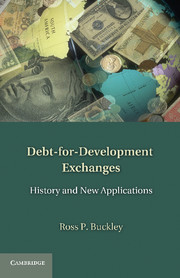Book contents
- Frontmatter
- Contents
- Acknowledgments
- List of Contributors
- Introduction: A Productive Partnership between Civil Society and the Academy
- Part I Types of Exchanges and Their Development over Time
- Part II Exchanges by Donor Countries
- Part III Critiques of Exchanges
- 10 Debt Audits: A Necessary Precondition to Credible Exchanges
- 11 How to Deal with Debt Illegitimacy in Relation to Debt Conversion: Reflections on an All-Too-Real Case
- 12 The Human Rights Dimension in Exchanges
- 13 Bangladesh's Experience with Exchanges: Liability to Potential
- 14 The Philippines' Experience with Exchanges
- Part IV Innovative Applications of Exchanges
- Conclusion
- Index
- References
14 - The Philippines' Experience with Exchanges
Published online by Cambridge University Press: 01 June 2011
- Frontmatter
- Contents
- Acknowledgments
- List of Contributors
- Introduction: A Productive Partnership between Civil Society and the Academy
- Part I Types of Exchanges and Their Development over Time
- Part II Exchanges by Donor Countries
- Part III Critiques of Exchanges
- 10 Debt Audits: A Necessary Precondition to Credible Exchanges
- 11 How to Deal with Debt Illegitimacy in Relation to Debt Conversion: Reflections on an All-Too-Real Case
- 12 The Human Rights Dimension in Exchanges
- 13 Bangladesh's Experience with Exchanges: Liability to Potential
- 14 The Philippines' Experience with Exchanges
- Part IV Innovative Applications of Exchanges
- Conclusion
- Index
- References
Summary
An account of debt-for-development exchanges in the Philippines provides a good demonstration of the evolution of the technique itself, evolving from a commercially driven transaction to one focussed on development projects and proposed by creditor countries. The Philippine experience sheds light on both the strengths and weaknesses of the debt-exchange technique and illuminates the opportunities and potential pitfalls in applying debt-for-development exchanges in the future. This chapter uncovers the manner in which debt-for-development exchanges can help developing countries overcome their dependence on external debt and harness their own resources for their developmental ends.
DEBT-FOR-DEVELOPMENT EXCHANGE FOR RURAL BANK REHABILITATION
In 1990 a World Bank team packaging a US$100 million agricultural loan identified a shortfall of capital in more than 800 rural banks in the Philippines that totalled about US$50million. It was estimated that the Philippine Deposit Insurance Corporation had a risk exposure of up to US$250 million of insured deposits in those banks. These banks also owed the Central Bank of the Philippines about US$75 million, which brought the total potential loss for the government to US$335 million should the banks fail. However, at the same time, they saw an opportunity because other banks had capital of about US$75 million in excess of the prescribed levels. Hence, the system had more than enough resources collectively to solve its problem. To effectively manage the funds from the World Bank loan, a merger of the rural banking system was identified as necessary.
- Type
- Chapter
- Information
- Debt-for-Development ExchangesHistory and New Applications, pp. 167 - 182Publisher: Cambridge University PressPrint publication year: 2011
References
- 1
- Cited by



